2007 CHEVROLET TRAIL BLAZER service
[x] Cancel search: servicePage 346 of 574
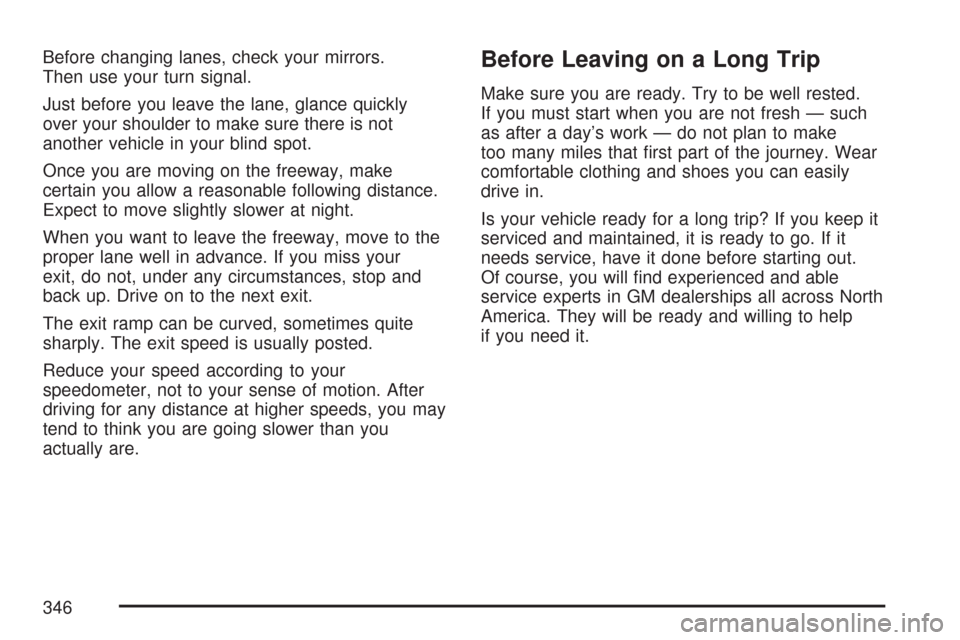
Before changing lanes, check your mirrors.
Then use your turn signal.
Just before you leave the lane, glance quickly
over your shoulder to make sure there is not
another vehicle in your blind spot.
Once you are moving on the freeway, make
certain you allow a reasonable following distance.
Expect to move slightly slower at night.
When you want to leave the freeway, move to the
proper lane well in advance. If you miss your
exit, do not, under any circumstances, stop and
back up. Drive on to the next exit.
The exit ramp can be curved, sometimes quite
sharply. The exit speed is usually posted.
Reduce your speed according to your
speedometer, not to your sense of motion. After
driving for any distance at higher speeds, you may
tend to think you are going slower than you
actually are.Before Leaving on a Long Trip
Make sure you are ready. Try to be well rested.
If you must start when you are not fresh — such
as after a day’s work — do not plan to make
too many miles that �rst part of the journey. Wear
comfortable clothing and shoes you can easily
drive in.
Is your vehicle ready for a long trip? If you keep it
serviced and maintained, it is ready to go. If it
needs service, have it done before starting out.
Of course, you will �nd experienced and able
service experts in GM dealerships all across North
America. They will be ready and willing to help
if you need it.
346
Page 347 of 574
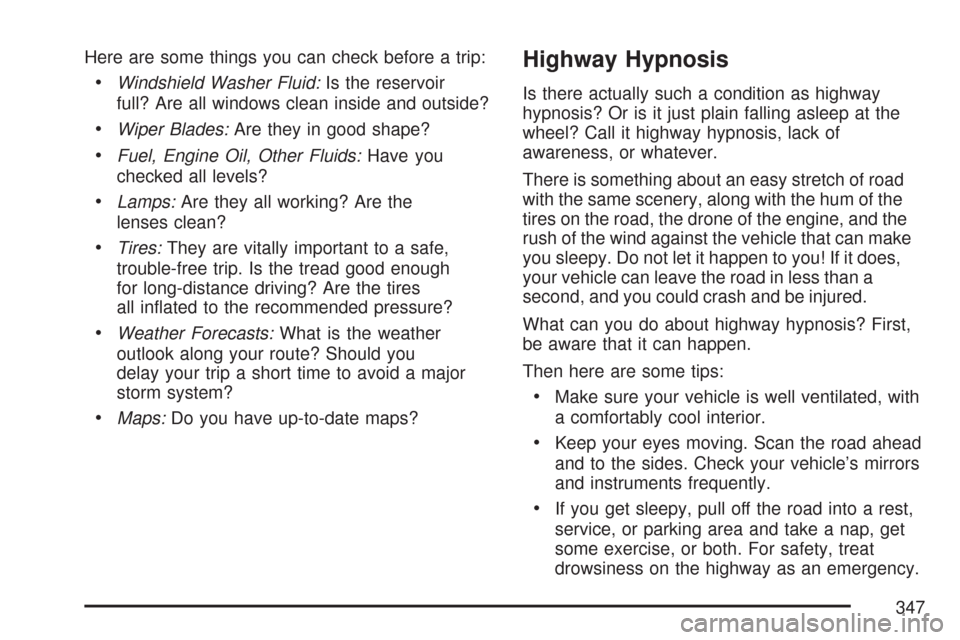
Here are some things you can check before a trip:
Windshield Washer Fluid:Is the reservoir
full? Are all windows clean inside and outside?
Wiper Blades:Are they in good shape?
Fuel, Engine Oil, Other Fluids:Have you
checked all levels?
Lamps:Are they all working? Are the
lenses clean?
Tires:They are vitally important to a safe,
trouble-free trip. Is the tread good enough
for long-distance driving? Are the tires
all in�ated to the recommended pressure?
Weather Forecasts:What is the weather
outlook along your route? Should you
delay your trip a short time to avoid a major
storm system?
Maps:Do you have up-to-date maps?
Highway Hypnosis
Is there actually such a condition as highway
hypnosis? Or is it just plain falling asleep at the
wheel? Call it highway hypnosis, lack of
awareness, or whatever.
There is something about an easy stretch of road
with the same scenery, along with the hum of the
tires on the road, the drone of the engine, and the
rush of the wind against the vehicle that can make
you sleepy. Do not let it happen to you! If it does,
your vehicle can leave the road in less than a
second, and you could crash and be injured.
What can you do about highway hypnosis? First,
be aware that it can happen.
Then here are some tips:
Make sure your vehicle is well ventilated, with
a comfortably cool interior.
Keep your eyes moving. Scan the road ahead
and to the sides. Check your vehicle’s mirrors
and instruments frequently.
If you get sleepy, pull off the road into a rest,
service, or parking area and take a nap, get
some exercise, or both. For safety, treat
drowsiness on the highway as an emergency.
347
Page 362 of 574
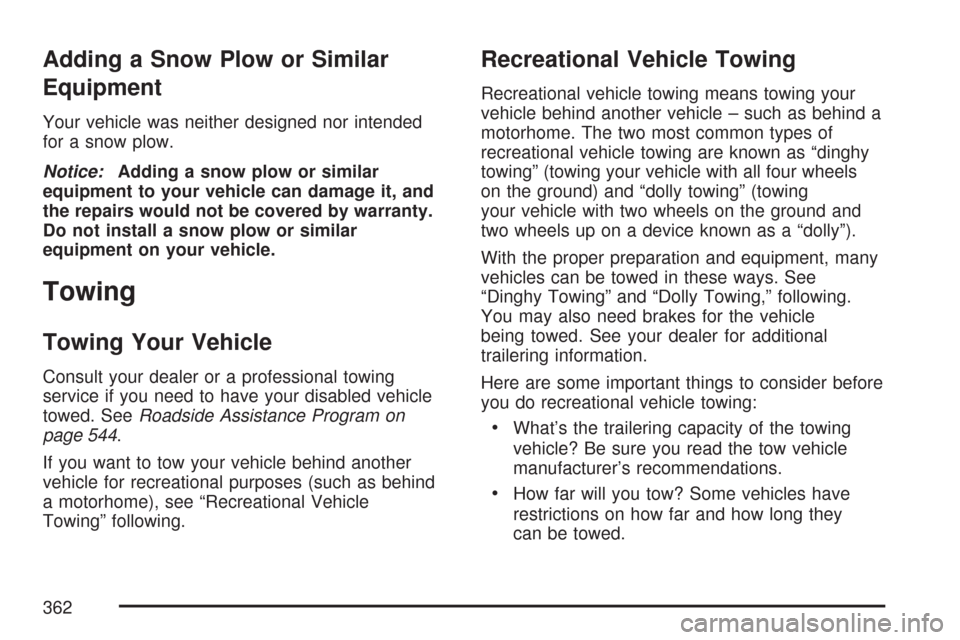
Adding a Snow Plow or Similar
Equipment
Your vehicle was neither designed nor intended
for a snow plow.
Notice:Adding a snow plow or similar
equipment to your vehicle can damage it, and
the repairs would not be covered by warranty.
Do not install a snow plow or similar
equipment on your vehicle.
Towing
Towing Your Vehicle
Consult your dealer or a professional towing
service if you need to have your disabled vehicle
towed. SeeRoadside Assistance Program on
page 544.
If you want to tow your vehicle behind another
vehicle for recreational purposes (such as behind
a motorhome), see “Recreational Vehicle
Towing” following.
Recreational Vehicle Towing
Recreational vehicle towing means towing your
vehicle behind another vehicle – such as behind a
motorhome. The two most common types of
recreational vehicle towing are known as “dinghy
towing” (towing your vehicle with all four wheels
on the ground) and “dolly towing” (towing
your vehicle with two wheels on the ground and
two wheels up on a device known as a “dolly”).
With the proper preparation and equipment, many
vehicles can be towed in these ways. See
“Dinghy Towing” and “Dolly Towing,” following.
You may also need brakes for the vehicle
being towed. See your dealer for additional
trailering information.
Here are some important things to consider before
you do recreational vehicle towing:
What’s the trailering capacity of the towing
vehicle? Be sure you read the tow vehicle
manufacturer’s recommendations.
How far will you tow? Some vehicles have
restrictions on how far and how long they
can be towed.
362
Page 368 of 574
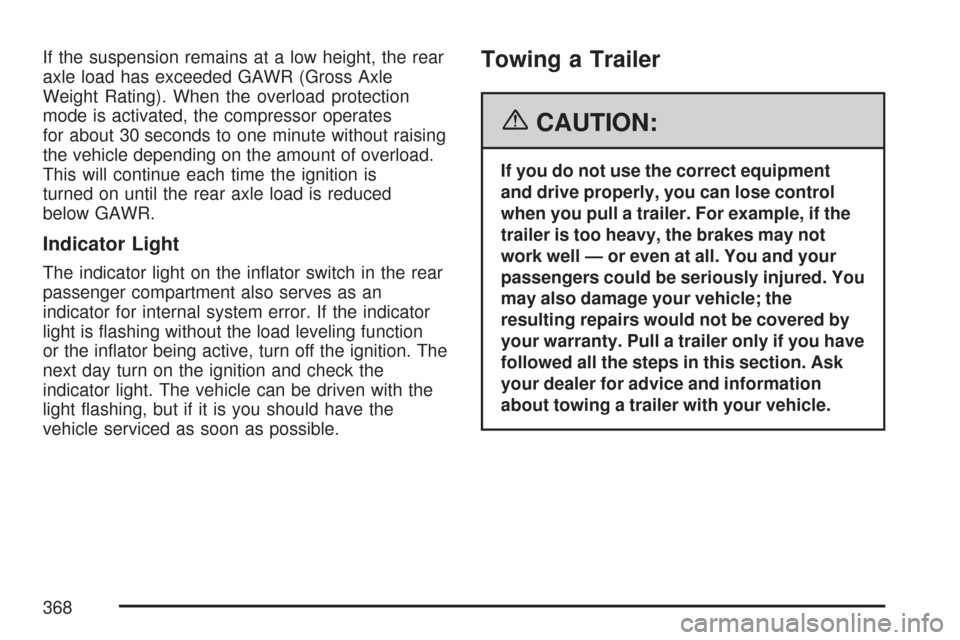
If the suspension remains at a low height, the rear
axle load has exceeded GAWR (Gross Axle
Weight Rating). When the overload protection
mode is activated, the compressor operates
for about 30 seconds to one minute without raising
the vehicle depending on the amount of overload.
This will continue each time the ignition is
turned on until the rear axle load is reduced
below GAWR.
Indicator Light
The indicator light on the in�ator switch in the rear
passenger compartment also serves as an
indicator for internal system error. If the indicator
light is �ashing without the load leveling function
or the in�ator being active, turn off the ignition. The
next day turn on the ignition and check the
indicator light. The vehicle can be driven with the
light �ashing, but if it is you should have the
vehicle serviced as soon as possible.
Towing a Trailer
{CAUTION:
If you do not use the correct equipment
and drive properly, you can lose control
when you pull a trailer. For example, if the
trailer is too heavy, the brakes may not
work well — or even at all. You and your
passengers could be seriously injured. You
may also damage your vehicle; the
resulting repairs would not be covered by
your warranty. Pull a trailer only if you have
followed all the steps in this section. Ask
your dealer for advice and information
about towing a trailer with your vehicle.
368
Page 380 of 574
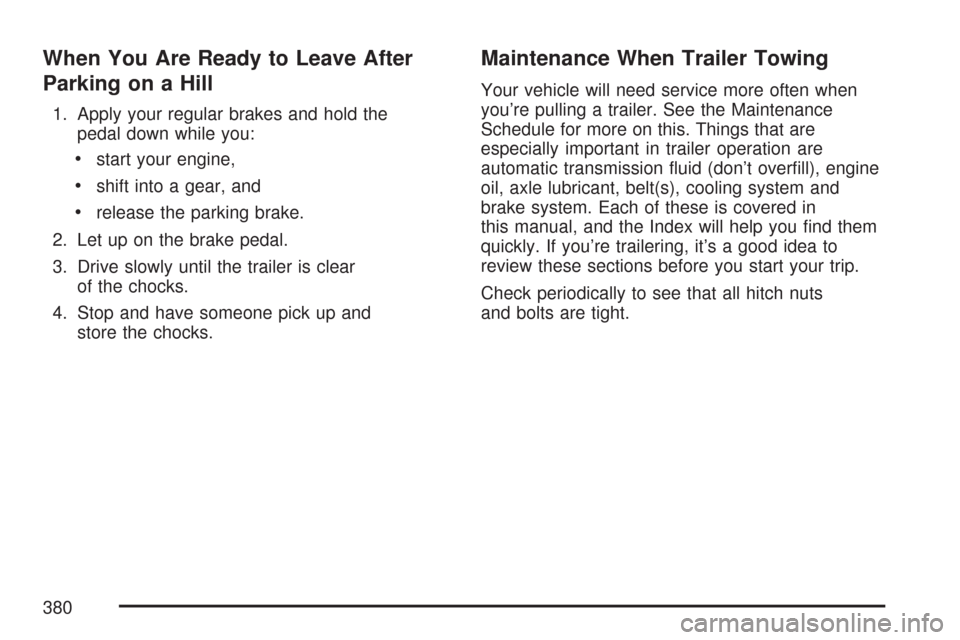
When You Are Ready to Leave After
Parking on a Hill
1. Apply your regular brakes and hold the
pedal down while you:
start your engine,
shift into a gear, and
release the parking brake.
2. Let up on the brake pedal.
3. Drive slowly until the trailer is clear
of the chocks.
4. Stop and have someone pick up and
store the chocks.
Maintenance When Trailer Towing
Your vehicle will need service more often when
you’re pulling a trailer. See the Maintenance
Schedule for more on this. Things that are
especially important in trailer operation are
automatic transmission �uid (don’t over�ll), engine
oil, axle lubricant, belt(s), cooling system and
brake system. Each of these is covered in
this manual, and the Index will help you �nd them
quickly. If you’re trailering, it’s a good idea to
review these sections before you start your trip.
Check periodically to see that all hitch nuts
and bolts are tight.
380
Page 382 of 574
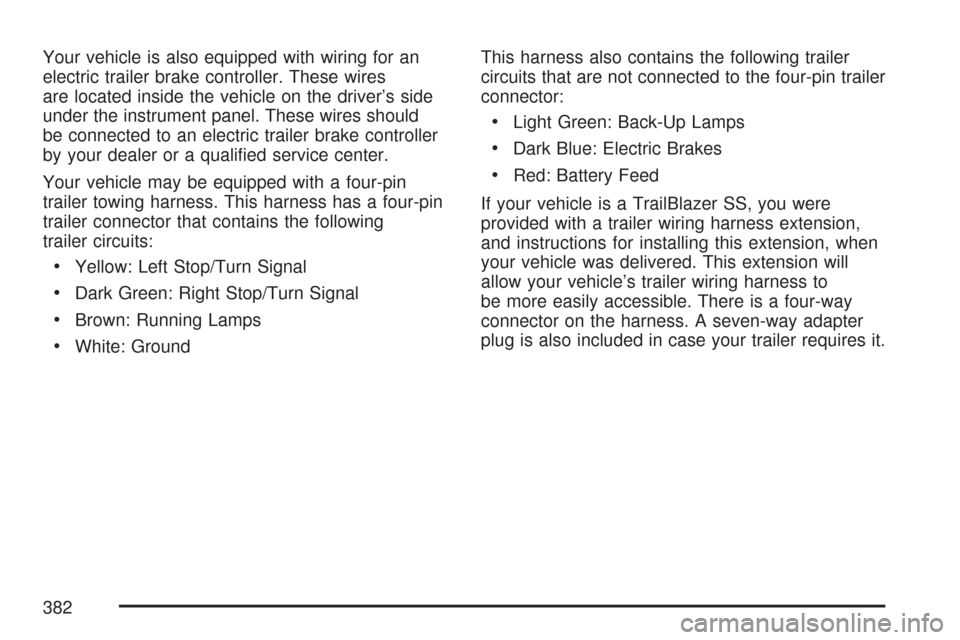
Your vehicle is also equipped with wiring for an
electric trailer brake controller. These wires
are located inside the vehicle on the driver’s side
under the instrument panel. These wires should
be connected to an electric trailer brake controller
by your dealer or a quali�ed service center.
Your vehicle may be equipped with a four-pin
trailer towing harness. This harness has a four-pin
trailer connector that contains the following
trailer circuits:
Yellow: Left Stop/Turn Signal
Dark Green: Right Stop/Turn Signal
Brown: Running Lamps
White: GroundThis harness also contains the following trailer
circuits that are not connected to the four-pin trailer
connector:
Light Green: Back-Up Lamps
Dark Blue: Electric Brakes
Red: Battery Feed
If your vehicle is a TrailBlazer SS, you were
provided with a trailer wiring harness extension,
and instructions for installing this extension, when
your vehicle was delivered. This extension will
allow your vehicle’s trailer wiring harness to
be more easily accessible. There is a four-way
connector on the harness. A seven-way adapter
plug is also included in case your trailer requires it.
382
Page 383 of 574
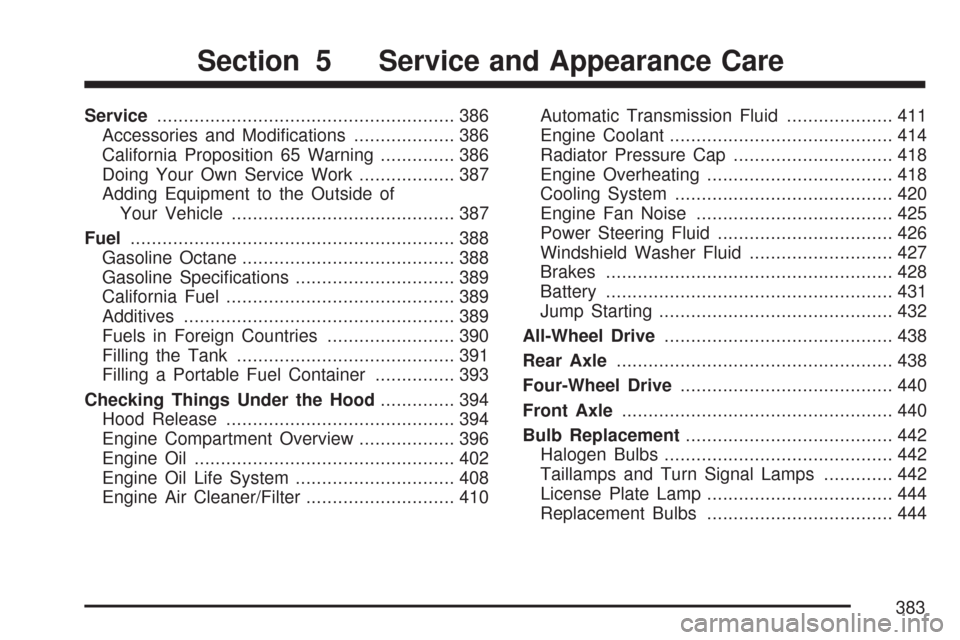
Service........................................................ 386
Accessories and Modi�cations................... 386
California Proposition 65 Warning.............. 386
Doing Your Own Service Work.................. 387
Adding Equipment to the Outside of
Your Vehicle.......................................... 387
Fuel............................................................. 388
Gasoline Octane........................................ 388
Gasoline Speci�cations.............................. 389
California Fuel........................................... 389
Additives................................................... 389
Fuels in Foreign Countries........................ 390
Filling the Tank......................................... 391
Filling a Portable Fuel Container............... 393
Checking Things Under the Hood.............. 394
Hood Release........................................... 394
Engine Compartment Overview.................. 396
Engine Oil................................................. 402
Engine Oil Life System.............................. 408
Engine Air Cleaner/Filter............................ 410Automatic Transmission Fluid.................... 411
Engine Coolant.......................................... 414
Radiator Pressure Cap.............................. 418
Engine Overheating................................... 418
Cooling System......................................... 420
Engine Fan Noise..................................... 425
Power Steering Fluid................................. 426
Windshield Washer Fluid........................... 427
Brakes...................................................... 428
Battery...................................................... 431
Jump Starting............................................ 432
All-Wheel Drive........................................... 438
Rear Axle.................................................... 438
Four-Wheel Drive........................................ 440
Front Axle................................................... 440
Bulb Replacement....................................... 442
Halogen Bulbs........................................... 442
Taillamps and Turn Signal Lamps............. 442
License Plate Lamp................................... 444
Replacement Bulbs................................... 444
Section 5 Service and Appearance Care
383
Page 384 of 574
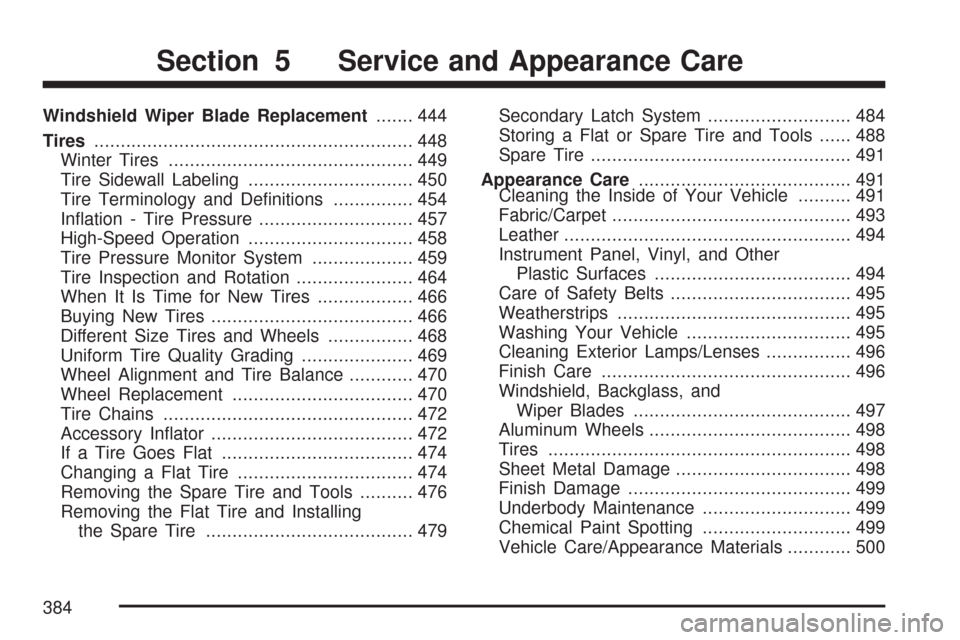
Windshield Wiper Blade Replacement....... 444
Tires............................................................ 448
Winter Tires.............................................. 449
Tire Sidewall Labeling............................... 450
Tire Terminology and De�nitions............... 454
In�ation - Tire Pressure............................. 457
High-Speed Operation............................... 458
Tire Pressure Monitor System................... 459
Tire Inspection and Rotation...................... 464
When It Is Time for New Tires.................. 466
Buying New Tires...................................... 466
Different Size Tires and Wheels................ 468
Uniform Tire Quality Grading..................... 469
Wheel Alignment and Tire Balance............ 470
Wheel Replacement.................................. 470
Tire Chains............................................... 472
Accessory In�ator...................................... 472
If a Tire Goes Flat.................................... 474
Changing a Flat Tire................................. 474
Removing the Spare Tire and Tools.......... 476
Removing the Flat Tire and Installing
the Spare Tire....................................... 479Secondary Latch System........................... 484
Storing a Flat or Spare Tire and Tools...... 488
Spare Tire................................................. 491
Appearance Care........................................ 491
Cleaning the Inside of Your Vehicle.......... 491
Fabric/Carpet............................................. 493
Leather...................................................... 494
Instrument Panel, Vinyl, and Other
Plastic Surfaces..................................... 494
Care of Safety Belts.................................. 495
Weatherstrips............................................ 495
Washing Your Vehicle............................... 495
Cleaning Exterior Lamps/Lenses................ 496
Finish Care............................................... 496
Windshield, Backglass, and
Wiper Blades......................................... 497
Aluminum Wheels...................................... 498
Tires......................................................... 498
Sheet Metal Damage................................. 498
Finish Damage.......................................... 499
Underbody Maintenance............................ 499
Chemical Paint Spotting............................ 499
Vehicle Care/Appearance Materials............ 500
Section 5 Service and Appearance Care
384